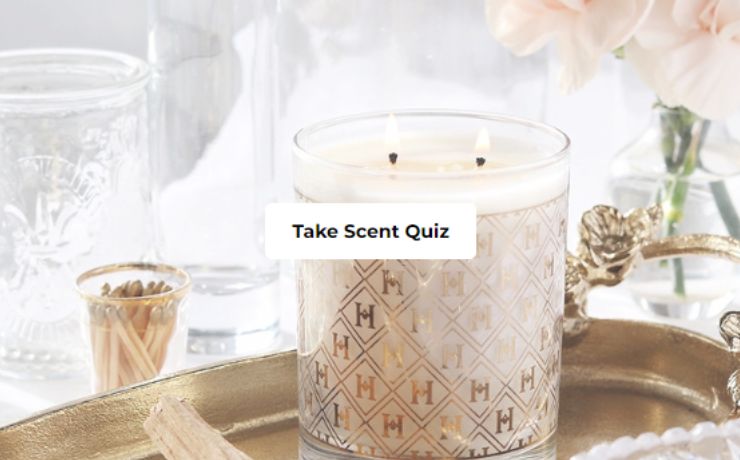How Long Should A Scented Candle Burn For The First Time?

Wondering how long you should burn your brand new candle for the first time?
In this article, we’ll explain why it’s so important that you allow the entire top layer of wax to melt from edge to edge of the candle container the very first time that you burn a new candle.
How Long Should A Scented Candle Burn For The First Time?
When lighting a brand new candle for the first time:
- Let it burn for 1 hour per inch of container diameter to reach a full melt pool.
- Don't let it burn for more than 4 hours without extinguishing the flame and trimming the wick.
Allowing your new candle burn for the proper amount of time during the first burn will help you prevent tunneling and help you get the best use out of your beautiful candles.
When burning a candle for the first time, your main goal should be to reach a full melt pool. In other words, you need to let the candle burn long enough that the top surface of wax melted from edge to edge of the container.
Do not blow out or snuff out the flame too early!
Once you've got a nice, evenly melted surface, it'll makes it easier and faster for the wax to melt to the edges the next time you burn your candle. This phenomenon is known as "candle wax memory".
So while you enjoy the candle’s lovely aroma for the first time, monitor the wax pool every now and then. When you notice the top surface of wax is melted from edge to edge of its container, you may extinguish the flame (preferably with a candle snuffer).
A good rule of thumb is to let your candle burn at least one hour per inch of container diameter.
For instance, if you were burning a brand new luxury candle from the Harlem Candle Co., you should let it burn for at least 3 hours during the first time because the container diameter is around 3 inches.
After you've achieved a full wax pool, you can extinguish the flame at any time. But try to avoid letting it burn for longer than 4 hours without trimming the wick.
As your candle burns, carbon residue builds up on the wick and causes it to take on an unsightly mushroom shape. This in turn can cause the flame to get too hot, produce smoke, and leave ugly black stains in your wax and container.
To avoid this, remember to trim your wick to around 1/4 of an inch at least every 4 hours of burn time.
Why Is The First Burn Time So Important?
Being careful about the first burn helps you prevent candle tunneling.
If you’ve never heard of this term, tunneling happens when only a small portion of wax melts around the candle wick while the outer rim remains hard.
Every time you re-light your candle, the originally melted portion gets lower and lower and the outer rim continues to remain unmelted (forming a vertical "tunnel" in the center of your candle).
This can significantly decrease the lifetime of your candle, causing it to burn out much faster. Plus, no one wants to see such an uneven surface of wax!
What Is Candle Wax Memory?
Candle wax memory is how we describe the behavior of wax after being melted and then hardened. The basic idea is that wax has a “memory” of sorts, which causes it to tunnel after an incomplete first burn.
If only a small portion of the wax melts, then hardens, the next time you burn your candle, that same portion of wax will melt at a quicker rate than the surrounding parts. This is due to the fact that the heat absorption properties of wax start to change once it has been melted and hardened again.
After an incomplete first burn, only a part of the wax is melted. The small part of the wax that was initially melted remains softer than the untouched wax even after returning to a solid state. It takes less heat to burn the softer portion of wax, which causes it to burn faster than the untouched wax.
The First Burn Time May Vary From Candle To Candle
One hour per inch of candle diameter is a good rule of thumb to follow, but sometimes the proper first burn time can be a little longer or shorter. This depends on several factors:
- Type of Wax - There are all sorts of waxes / wax blends used for candles including soy, paraffin, beeswax, coconut etc., which burn at different rates. For instance, soy wax candles burn slower than paraffin candles, so they may need more time to reach a full melt pool.
- Wick Size - Larger wicks generally mean hotter flames, which causes wax to melt faster.
- Number of Wicks - A candle with one wick doesn't burn as quickly as a candle with two or more wicks.
- Type of Wick - There are several categories of wicks, including flat braid wicks, square braid wicks, cored wicks, and wooden wicks, which all burn slightly differently.
- Wax Additives - The presence of different fragrance oils and wax additives such as vybar, UV inhibitor, stearic acid, etc. can also affect burn times.
While it’s nice to know that these factors can have an effect on first burn time, it’s not necessary to do a deep analysis of the materials that make up your candle before burning it.
As long as remember to let your candle reaches a full melt pool after the first burn, you'll be fine!




